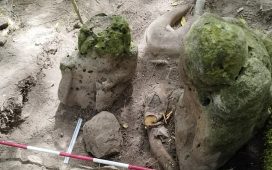A Florida man has discovered remains of a prehistoric monster that could be 10 million years old.
Alex Lundberg, 29, was diving with his friend near Venice Beach when he pulled a four-foot mastodon tusk from 25 feet below the surface.
The tusk turned out to from a mastodon – a distant relative of the woolly mammoth – that lived 10 million years ago, Lundberg said.
An expert at the Bradenton’s Bishop Museum of Science and Nature verified the discovery which is considered ‘super rare’ because only prehistoric shark teeth and broken pieces of mammoth tusks are typically found in the area.
Lundberg will need to report his findings the Florida Museum of Natural History to determine if it has any scientific value.
Mastodon tusks that are typically only a few inches in length have sold for as low as $20 to $350, but Lundberg speculated that the value of his 60-pound tusk is about $5,000.

Alex Lundberg (left) was diving with his friend, Blair Morrow (right) near Venice Beach when he discovered a four-foot mastodon tusk

Alex Lundberg (pictured holding the mastodon tusk) said he hopes he can keep the fossil and was surprised it remained intact as he pulled it from the water
The part-time scuba diver and fossil hunter said it was surreal that the mastodon tusk didn’t break apart when he removed it from the sea floor.
‘I swim over to it and start fanning it and all of a sudden there’s a huge section of it exposed and I’m just thinking to myself, oh my God, this is a tusk,’ Lundberg told ABC7 News.
‘I just show [Morrow] this four-foot tusk and her eyes just light up,’ he continued.
‘We made a sling out of a beach towel and kind of hoisted it over the side of the boat. It’s absolutely surreal that it came up in one piece, didn’t break apart at all.’
Lundberg has searched for fossils near Venice Beach for five years and said the area is known for thousands of fossilized shark teeth that are estimated to be roughly 10 million years old.
Speaking about the tusk, Lundberg told Tampa Bay News: ‘This is once in a lifetime, is what I’ve been told.’

The tusk (pictured) weighed about 60 pounds and is likely millions of years old

The mastodon lived 5.4 million years ago up until 10,000 years ago when it went extinct. It is a distant relative of the modern-day elephant
Mastodons are an extinct relative of modern elephants that were widespread across North America up until about 10,000 years ago.
The fossils are typically commonly found in well-preserved Pliocene age deposits from 5.4 to 2.4 million years ago and the subsequent Pleistocene age that lasted from 2.5 to 11,000 years ago.
Mastodon fossils including tusks, bones, and skulls are common in just four states across the US: Indiana, Colorado, California and New York – making its appearance in Florida incredibly unusual.
There are only about one dozen full mastodon skeletons that have been found in Florida, compared to more than 140 in New York State alone.

The tusk was located about 25 feet below the water off the coast of Venice Beach, Florida

Alex Lundberg (pictured) will need to share his findings with the Florida Museum of Natural History which will decide if the tusk is scientifically significant or if he can keep it
‘All paleontologists are looking for that kind of diamond in the rough,’ Hunter Windham, an education specialist with Bradenton’s Bishop Museum of Science and Nature told Tampa Bay.
‘The great thing about Florida, especially if you’re looking for animals that were around during the last ice age, is that the coastline extended way further out than today. So these animals were walking on dry land up to 50 or 60 miles out to the Gulf of Mexico relative to us today,’ he added.
Lundberg will need to share his findings with the Florida Museum of Natural History which will decide if the tusk is scientifically significant or if he can keep it but he remains hopeful that it can stay in his family.

Mastodon fossils are typically commonly found in well-preserved Pliocene age deposits from 5.4 to 2.4 million years ago and the subsequent Pleistocene age that lasted from 2.5 to 11,000 years ago. Pictured: Lundberg’s dog hovers over the mastodon tusk
‘It’s just been kind of rolling around on the ocean floor for at least the last 10 million years,’ he told USA Today.
‘Its scientific value is limited, it’s just more of a cool display piece at this point.’
In a separate interview, Lundberg told Tampa Bay: ‘I told my girlfriend, this tusk is going to go to our kids and our grandkids, like, this is a family tusk now. It’s part of the family.’
DailyMail.com has reached out to Alex Lundberg for comment.











